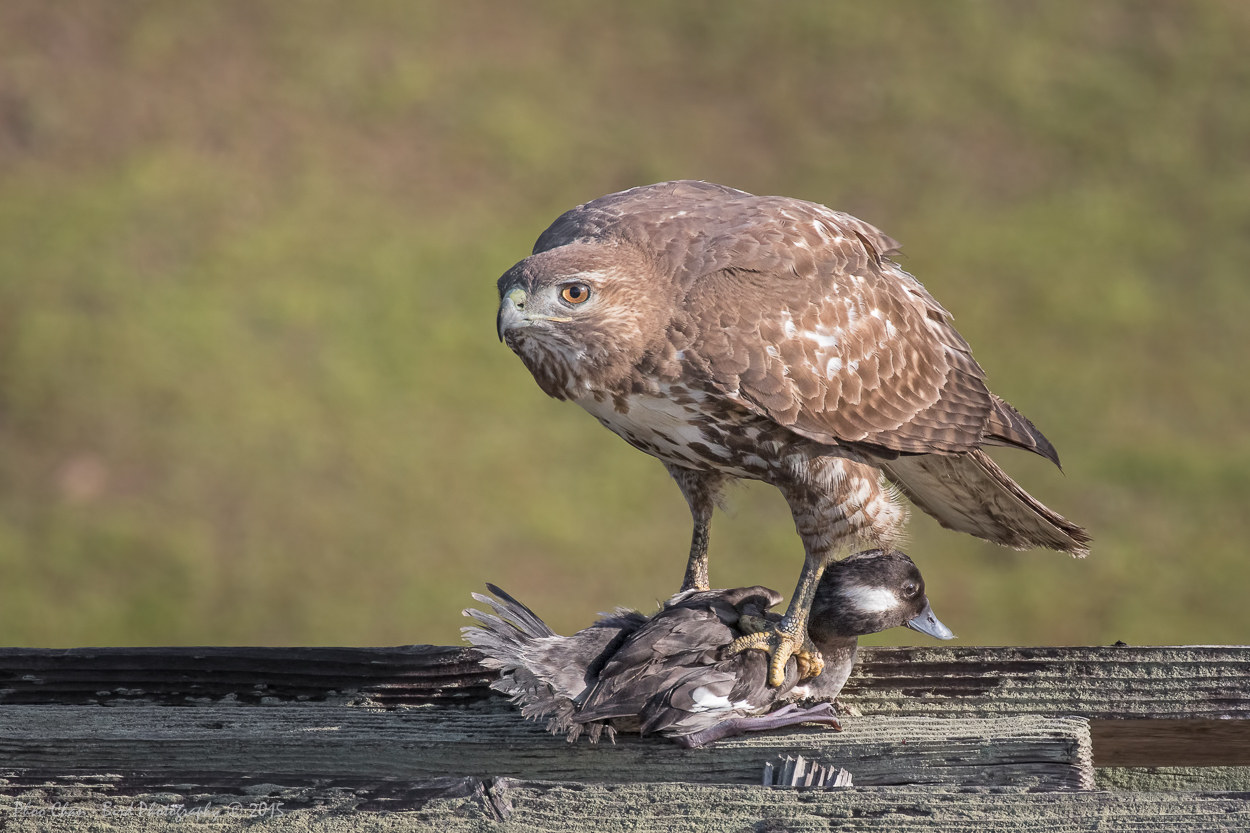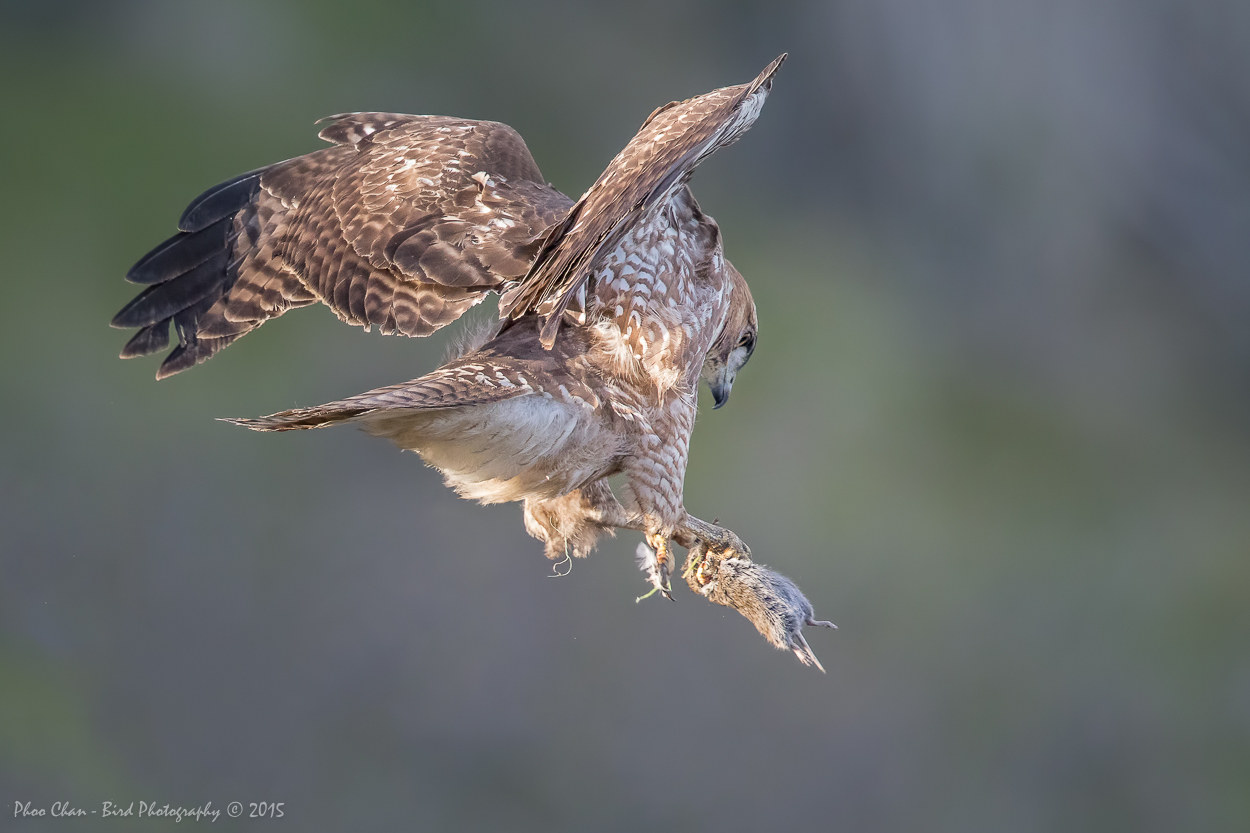The Red-tailed Hawk of CHRP
As she was just about to gain elevation from the launch, searching for a new feeding spot, little did she know a pair of preying eyes had been intensely shadowing her every little move from a nearby tree. A golden window of opportunity finally opened up for the hungry, cold juvenile Red-tailed hawk, who had been hunting to no avail since the break of dawn. Not wasting such an opportunity, the young raptor simply seized the ill-fated female bufflehead in the mid-air with little struggle. It took over three hours for the hawk to devour its fresh catch.
 This was such an adrenaline rush and gruesome scene to witness, yet this is just another typical rule of the wildlife..
This was such an adrenaline rush and gruesome scene to witness, yet this is just another typical rule of the wildlife..
Now, how’s that for an opening, talk about being dramatic.. No doubt it was a little carried away, but the bufflehead does deserve some extra attention.
 Almost all bird photographers would be all ears when the subject being discussed is hawk, especially hawk in flight, or better yet, hawk in actions. It’s almost like little boys would pay more attention when you show them a firetruck.
Almost all bird photographers would be all ears when the subject being discussed is hawk, especially hawk in flight, or better yet, hawk in actions. It’s almost like little boys would pay more attention when you show them a firetruck.
 Red-tailed Hawk (RTH), which is the subject of this blog post, is the most common hawk found in North America, yet it never fails to seize attention from bird photographers. You usually see them soaring above open fields during your long car ride.
Red-tailed Hawk (RTH), which is the subject of this blog post, is the most common hawk found in North America, yet it never fails to seize attention from bird photographers. You usually see them soaring above open fields during your long car ride.
 You may also see them atop of power poles or even perched along the power cables. Their scream, the most favorite scream of all raptors, is used widely by movie makers on their soundtrack if they simply include a scene with some birds of prey.
You may also see them atop of power poles or even perched along the power cables. Their scream, the most favorite scream of all raptors, is used widely by movie makers on their soundtrack if they simply include a scene with some birds of prey.
 I have taken hundreds of images of this RTH, yet there are no two images the same, and that’s what makes it very interesting to keep getting more and more of it. Since we’re still on CHRP series, I will be focusing on RTH from CHRP only.
I have taken hundreds of images of this RTH, yet there are no two images the same, and that’s what makes it very interesting to keep getting more and more of it. Since we’re still on CHRP series, I will be focusing on RTH from CHRP only.
 It was last January when we had a few RTHs showing up around the same spot everyday after a series of heavy rain that brought the park alive again after suffering a long drought.
It was last January when we had a few RTHs showing up around the same spot everyday after a series of heavy rain that brought the park alive again after suffering a long drought.
 The rain simply flushed the voles out of their burrows, seeking a higher ground to escape from being drowned. This chaos simply invites raptors such as RTH, Northern Harrier, and White-tailed Kite, while egrets and herons alike fond to feast on these small rodents, also known as field mice. After over two years of severe drought, Coyote Hills Regional Park of Fremont California once again was attracting wildlife and green vegetation alike energizing the once lethargic ecosystem.
The rain simply flushed the voles out of their burrows, seeking a higher ground to escape from being drowned. This chaos simply invites raptors such as RTH, Northern Harrier, and White-tailed Kite, while egrets and herons alike fond to feast on these small rodents, also known as field mice. After over two years of severe drought, Coyote Hills Regional Park of Fremont California once again was attracting wildlife and green vegetation alike energizing the once lethargic ecosystem.
 The adult’s favorite dining spot has been on a branch of a dead tree near the Quarry staging area. Perhaps the view overlooking the marsh field with a still pond makes the spot a favorite dining place.
The adult’s favorite dining spot has been on a branch of a dead tree near the Quarry staging area. Perhaps the view overlooking the marsh field with a still pond makes the spot a favorite dining place.
 Every time it caught a fresh vole, it would bring it to the perch and slowly bit off till the last bit while its head kept turning left and right, fully alert of its surroundings.
Every time it caught a fresh vole, it would bring it to the perch and slowly bit off till the last bit while its head kept turning left and right, fully alert of its surroundings.
 The juvenile, on the other hand, would prefer to bring its catch to the roof top of a shaded bar-be-q shelter right at the Quarry staging area parking lot.
The juvenile, on the other hand, would prefer to bring its catch to the roof top of a shaded bar-be-q shelter right at the Quarry staging area parking lot.
 Just like any other juveniles, this raptor is not afraid of people, as if they are part of its ecosystem. It would continue to enjoy its catch even when someone got really close to capture its picture with a mobile phone.
Just like any other juveniles, this raptor is not afraid of people, as if they are part of its ecosystem. It would continue to enjoy its catch even when someone got really close to capture its picture with a mobile phone.
 I mentioned in the other blog post that I shoot mostly handheld, but in the case of this RTH, I used a monopod sometime, especially when getting ready to shoot the RTH taking off.
I mentioned in the other blog post that I shoot mostly handheld, but in the case of this RTH, I used a monopod sometime, especially when getting ready to shoot the RTH taking off.
I would miss a few frames if I were to shoot handheld. The RTH would give you a signal when it’s ready to take off by looking left and right with full alert. That’s when you have to get ready. Other raptors like the Golden eagle or Bald eagle would simply poop before taking off.
 Either way, most raptors would be taking off against the wind direction to give them the extra lift. It’s not all the time you get the RTH taking off towards your direction, so luck also plays a big role in getting shots like this. Most of the time you would be getting what photographers refer as butt shots, which you all don’t get to see and not many of us are proud of.
Either way, most raptors would be taking off against the wind direction to give them the extra lift. It’s not all the time you get the RTH taking off towards your direction, so luck also plays a big role in getting shots like this. Most of the time you would be getting what photographers refer as butt shots, which you all don’t get to see and not many of us are proud of.
Photo courtesy of Thinh Bui



